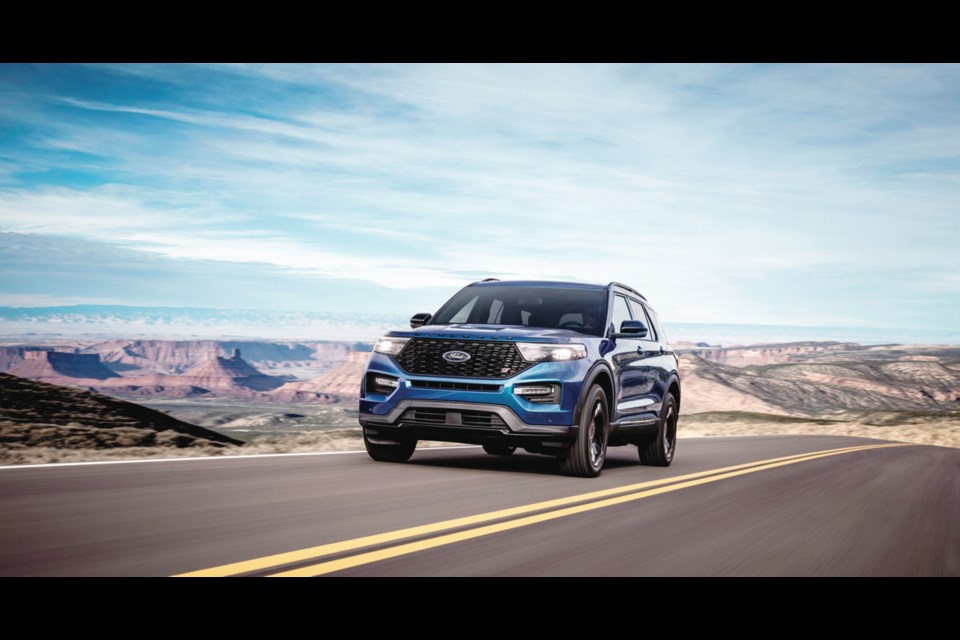Don’t let the familiar shape fool you. The sixth-generation Ford Explorer is about as new as the first Explorer that rolled off the line for the 1991 model year.
The numbers of utility vehicles with three rows of seats for seven or more passengers are definitely on the upswing. The group now includes the recently launched Hyundai Palisade and Kia Telluride, and on the luxury spectrum, the BMW X7 with three rows of seats is also brand new, as is the Lincoln Aviator.
The Aviator and the Explorer share the same newly developed rear-wheel-drive platform. The engine is now positioned with the crankshaft in line with the vehicle instead of 90 degrees, as was the previous front-wheel-drive layout.
Compared with its predecessor, the new Explorer is longer by about two centimetres and is equal in width. The distance between the front and rear wheels grows by about 15 centimetres, which Ford says benefits occupants in all three rows.
Along with some familiar design cues, including the wrap-around side windows that appear to blend with the liftgate glass, the sweeping side creases accentuate the Explorer’s length, while the grille is more intricately designed.
The dashboard is a mixture of classy and perhaps confusing. The optional 12.3-inch digital gauge display is certainly up to date, as is the 6.5-inch touch screen in the centre stack. The optional 10.1-inch screen appears as though someone left their iPad perched between the air vents, which is visually jarring.
On the plus side, a rotary dial, which replaces the traditional shifter, allows for unfettered access to the audio and climate controls, and an available wireless charging pad.
The new Explorer has three engine options. The base model comes with a turbocharged 2.3-litre four-cylinder that puts out 300 horsepower and 310 pound-feet of torque. That’s a gain of 20 and 10 over the 2019 version.
Optional is a twin-turbocharged 3.0-litre V-6 that’s rated at 365/380. Those numbers climb to 400/415 with the ST trim.
Those seeking performance and fuel efficiency should consider the Explorer Hybrid. It’s a non-plug-in version that combines a turbocharged 3.3-litre V-6 and an electric motor for 318 horsepower and 322 pound-feet.
The Hybrid’s battery pack is located beneath the passenger-side front seat and the second-row foot well. As with similar gasoline-electric systems, it helps reduce fuel consumption while providing only brief periods of electric-only power, which can be useful in stop-and-go and urban situations.
Every model gets a 10-speed automatic transmission, which replaces the six-speed. Fuel-consumption numbers for the Hybrid haven’t been released, but Explorers with the turbo four-cylinder are rated at 11.6 l/100 km in the city, 8.7 on the highway, and 10.3 combined.
Ford’s so-called Intelligent four-wheel-drive is standard with all models. For towing, the V-6 can handle up to 2,545 kilograms, but the turbo four-cylinder is also no slouch in that department at 2,410.
Pricing starts at $47,150 (XLT), including destination charges. That sum gets you a fairly well equipped vehicle, including the company’s Co-Pilot 360 suite of dynamic-safety technologies (with features such as emergency braking, active cruise control and lane-keeping assist).
The Limited includes such features as leather upholstery, 12-speaker Bang and Olfusen-brand sound system and a surround-view camera.
The ST gets the 400-horsepower V-6, a sport-tuned suspension and blacked-out trim, while the Platinum comes with the 365-horse V-6, premium-leather seats and a twin-panel moonroof as part of its healthy dose of standard gear.
Note that the Hybrid comes in one trim — Limited — at $59,150, which is about $5,000 more than the non-hybrid Limited.
A clear departure from the norm — particularly when it comes to the rear-wheel-drive layout and the powertrain choices — is what sets the Explorer on a new family-hauling path.
The extra size and new technology make it that much more versatile.
THE SPEC SHEET
Type: Four-door, all-wheel-drive sport utility vehicle
Engines (h.p.): 2.3-litre DOHC I-4, turbocharged (300) 3.0-litre DOHC V-6, twin-turbocharged (365/400, ST) 3.3-litre DOHC V-6, turbocharged, with electric motor (318)
Transmission: 10-speed automatic
Market position: The Explorer is now the only non-luxury utility vehicle built on a rear-wheel-drive platform (four-wheel-drive is standard). Ford claims a roomier cabin and improved driveability.
Points: Easily identifiable despite receiving significant structural and visual changes.
• Choice of three powertrains; standard 10-speed automatic transmission.
• Optional 10.1-inch touch screen is easily viewed, but its position spoils an otherwise stylish dashboard.
• More legroom for all three rows of seats.
• Hybrid powertrain limited to the Limited.
Active safety: Blind-spot warning with cross-traffic backup alert (std.); active cruise control (std.); emergency braking (std.); pedestrian detection (std.)
L/100 km: (city/hwy) 11.6/8.7 (2.3)Base price: (incl. destination) $47,150
BY COMPARISON
Chevrolet Traverse AWD
Base price: $40,900
Well-priced wagon is similar in size to the Explorer. A 310-h.p. V-6 is standard.
Toyota Highlander AWD
Base price: $41,700
Popular eight-passenger model is available as a 306-horsepower hybrid.
Kia Telluride AWD
Base price: $47,000
New for 2020 model comes with a 291-horsepower V-6 plus loads of cabin space.



